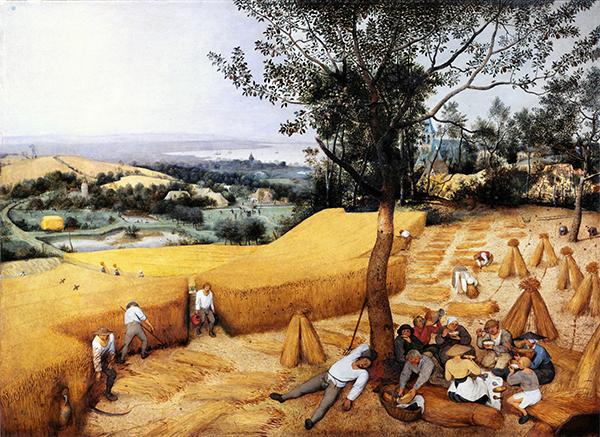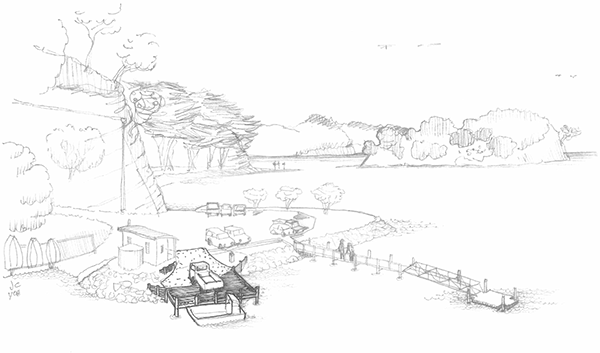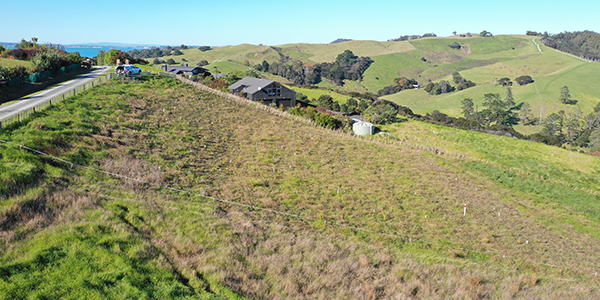Transcending community–council boundaries in wahapū Mahurangi
author Cimino published 6 October 2021 notified 14 October 2021

First Modern Landscape: To illustrate the height of the traditional cultivar of wheat, Vaclav Smil, in his characteristically iconoclastic, numbers-dense Grand Transitions: How the Modern World Was Made, uses an uncoloured engraving after Pieter Bruegel the Elder, rather than this “watershed in Western art” by the brush of the master himself. Post-Green-Revolution wheat is only about 50% straw, compared to the 70–80% in Bruegel’s day. Smil, meanwhile, cites Wilkinson 2005 regarding the order-of-magnitude higher rate of anthropogenic denudation—an estimated average of 21 000 tonnes of sediment is generated per year, just in the Mahurangi watershed. artist Pieter Bruegel the Elder
When the organisation Mahurangi Action was formed in December 1974, the local town council was seen as the enemy.
The proximate threat, in the eyes of the community, was that the town council’s plans for a new wastewater treatment plant would sentence the Mahurangi River and estuary to remain unswimmable and unsafe for oyster farming, indefinitely. Although the regional water board of the day was convinced by the community’s arguments in favour of a joint scheme servicing the tidehead town, and the Mahurangi peninsula settlements, the town council built a separate wastewater treatment plant. It proved a costly and shortsighted decision. The facility will be retired in 2025, covid-19 having pushed out the projected date for the opening of the new treatment plant.
Since 1974, however, regional and unitary councils have been ahead of the community in identifying the most significant proximate threat: the Mahurangi estuary’s elevated sediment accumulation rate. Currently, the Mahurangi is the recipient of the second major funding programme committed to reducing catchment soil loss, delivered as an Auckland Council – Ngāti Manuhiri partnership.
In 1977, Mahurangi Action revived the circa 1850s Mahurangi Regatta, to demonstrate that the society—which was then titled Friends of the Mahurangi—was more than about objecting to council plans. The regatta filled a powerful need to rebuild a community that had become physically divided by its harbour, since all-weather roads put an end to the steamboat service to Scotts Landing. Provided that this summer’s pandemic alert-levels permit and it otherwise appears to be prudent, the regatta will host an eloquent wahapūin this instance: estuary. Also, river mouth, and, most wonderfully, used adjectivally: eloquent, articulate, well-expressed Mahurangi, transcending-boundaries exposition staffed by community–council coastal trail, land and river-navigability restoration, and pest control teams.
Whether an account of this experience, and the ongoing mission of Mahurangi Action, could be useful to others with roles in integrated estuaries management is now for a guest editorial team to discern, from the following outline:
Transcending community–council boundaries in wahapū Mahurangi
Since 1974, a Mahurangi incorporated society has worked with and against council programmes and projects, from expedient wastewater treatment plans to a second, $5 million by 5-year programme to reduce the harbour’s elevated sediment accumulation rate. Along the way, the society has revived a regionally important regatta, published a 416-page history of the Mahurangi, defended public foreshore access, and preserved a significant regional park beach, car-free. Be that as it may, the challenge of fully justifying the organisation’s middle name—Action—is yet to be achieved. If, however, the society’s current determination to catalyse a Waiwera to Waipū coastal trail is successful, the opportunity to showcase integrated estuaries management, against the backdrop of the highly scenic, largely unbuilt Mahurangi Harbour, and 1000 contiguous hectares of regional parkland on the doorstep of Tāmaki Makaurau, would be difficult to surpass.

Transcending Scotts Boundaries: In a bid to transcend the divide between property holders and oyster farmers, facilitated by Mahurangi Action, one oyster farmer commissioned this rendering to illustrate a solution to the clash of uses of Scotts Landing proper. Later, the image illustrated another transcending-boundaries example, and milestone submission to Auckland Council along the journey to last year’s government announcement of funding for the Mahurangi River Restoration Trust’s dredging programme.
rendering Jefferson Chapple
While oysters are comparatively physiologically tolerant of episodes of elevated suspended-sediment levels, the microalgae on which the oysters feed is highly dependent on sunlight penetration of the water column. Cloudy days and cloudy water are not optimal for growing and fattening oysters. Mahurangi Action’s founding chairman John Male was opposed to the proliferation of Mahurangi oyster farms beyond the moratorium that he insisted had been agreed to by the former Rodney County Council, during the single term he endured as a councillor. However, smartly realising that they were natural allies,
Mahurangi oyster farmers and the organisation formed a constructive, and enduring, working relationship.
Another reconciliation saw the former Warkworth Town Council chairman chair Mahurangi Action, in the late 1980s—the enthusiastic writer and illustrator supported the publication of Dr Ronald Locker’s masterful Jade River: A History of the Mahurangi. A hint of what the former town-council chair had had to work with was the defiant declaration of one councillor, to the effect:
We’ve just spent a fortune treating the Mahurangi River before it gets to Warkworth, damned if we are going to pay to treat it again downstream!
Upstream, the councillor was referring the town’s first potable water treatment plant. Such reticence to address threats to public health echoed the mentality of a 1918 Pandemic decision of the same town council, in voting to convert half the men’s public toilet into a morgue.
Half measures appear to be the hallmark of representative democracy, not least of all the arguably months-premature New Zealand decision to abandon covid-19 elimination. In predicting modern civilisation’s response to anthropogenic global heating, the international response to the sars-cov-2 virus confirms the sober warnings of formidable energy researcher Vaclav Smil, who cautions that government targets regarding the time in which zero-fossil-fuels transitions can be completed are implausible. Not that he stoops to state in so crude a terms, Smil details that to replace the energy infrastructure that has taken centuries to build, within a few decades—built for and with the benefits of profoundly energy-dense fossil fuels, and increased in capacity to accommodate developing economies, without the further assistance of fossil fuels—amounts to modern civilisation fancying that it can lift itself up by its own bootstraps.
Smil serially refuses to make predictions. Soundly, given that neither climate sensitivity nor civilisation’s response to the strong possibly that it is already sorely testing the boundaries of that sensitivity, are presently knowable.

Transcending Land Restoration Boundaries: As with the 2004– Mahurangi Action Plan, the current Mahurangi land restoration project is up against the systemic issue of the eye-watering cost of re-establishing indigenous species, as compared to exotics. This 2020– trial seeks to identify what combination of density and plant size of harakeke planted might lead to a spray-plant-and-walk-away regime. Harakeke—New Zealand ‘flax’—is famous for providing perches for indigenous-seed-distributing birds.
drone image Michael Bergin | Environmental Restoration Limited
Although Smil disdains to even hint as much, with the very habitability of significant regions of the earth at stake, heroic climate emergency measures arguably may make a world of difference. Whether they be a youth-led partial-moratorium on procreation, the world’s largest pumped hydro storage scheme, at-scale manufacture of zero-carbon accommodation, or other globally head-turning demonstrations that could emanate from Aotearoa.
That which universally masquerades as representative democracy is demonstratively dysfunctional. It is thoroughly unfit-for-purpose in waging the honourable war to salvage a survivable climate from an increasingly, relentlessly hostile one, for humanity and its long-suffering fellow species. The world’s first full democracy, Aotearoa, should not be self-conscious about, if not going early, going hard, demonstrating practicable, democratic climate-action mobilisation. Nor should the Mahurangi resile from transcending boundaries to deploy every estuarine beauty to beguile and appeal to New Zealanders’ and to all Homo sapiens sapiensas opposed to Homo sapiens, to acknowledge Homo sapiens idaltu, and to avoid the more cumbersome alternative of ‘anatomically modern human being’, and for sheer cussedness ’ wiser angels.
Royal Society submission A special issue of the New Zealand Journal of Marine and Freshwater Research is being planned to coincide with the 2022 Joint Conference of the New Zealand Marine Sciences and Freshwater Sciences societies. Expressions of interest in papers that focus on the integrated management of New Zealand estuaries were called for on 26 August, with this desk being kindly notified by Auckland Council five days ago. Distilling a compelling “short descriptive paragraph outlining the scope of your proposed manuscript”, along the lines of the summary above, by the 7 October deadline will be suitably challenging.
Healthy Harbours Waterways Fund Open for applications until Friday 26 November, the Rodney Healthy Harbours Waterways Fund, for the fourth year running, is providing grants to reduce sediment generation by fencing stock out of Kaipara ki Mahurangi streams and harbours.
Pumped hydro milestone Crucially, if Aotearoa is to become a zero-carbon role model, the government is staying the course with its leaders-debate commitment to explore pumped hydro storage. Not only is Lake Onslow at-scale, it would be the world’s largest such scheme, dwarfing Snowy 2.0. At 5 twh of storage, Onslow would be 14 times larger than the Snowy 2.0 scheme, which is at the tunnel-boring stage. Further, it would be 20 000 times larger than California’s Gateway. At current at-scale lithium storage prices, Onslow built as an actual battery would be cost about $1.2 trillion, rather than the $4 billion estimated.
Disclosure The author of this article is the secretary of both Mahurangi Action Incorporated and the Mahurangi Coastal Trail Trust. The account published here, however, is that of the editorially independent, independently funded Mahurangi Magazine. last updated 17 October 2021



